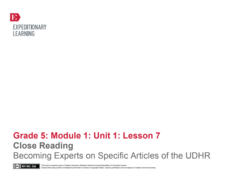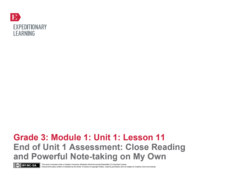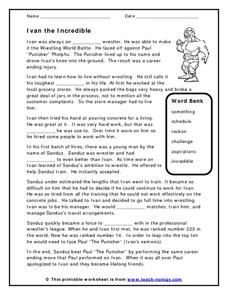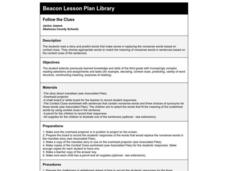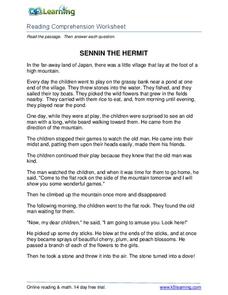EngageNY
Close Reading: The Introduction to the Universal Declaration of Human Rights
As part of a group of lessons, your class will return to the primary text for this unit, the Universal Declaration of Human Rights. Key vocabulary as well as close reading strategies continue to be the focus skills; however, this lesson...
Vocabulary A-Z
5-Day Vocabulary Teaching Plan
Reinforce important reading skills with a set of vocabulary lesson plans. Middle schoolers complete sentences, play word games, finish analogies, and build their growing vocabulary with a packet of helpful and applicable graphic organizers.
EngageNY
Close Reading: Unpacking Specific Articles of the UDHR
Lesson 6 of this extensive unit finally has your class begin to work their way through specific articles from the text of the Universal Declaration of Human Rights (UDHR). Before examining the rights actually detailed in the...
EngageNY
Close Reading: Becoming Experts on Specific Articles of the UDHR
A continuation of the previous lesson, which is part of a larger group of lessons on human rights (see additional materials). Here, in Lesson 7, your class will explore more articles from the Universal Declaration of Human Rights. After...
TLS Books
Vocabulary Practice
Using context clues is a valuable skill in reading comprehension. Help kids to learn about homonyms with a multiple-choice worksheet, in which they read two sentences and fill in the blanks with the word that would work in both.
EngageNY
End of Unit 1 Assessment: Close Reading and Powerful Note-Taking on My Own
As the final lesson plan in a larger beginning-of-the-year unit to establish routines and teach close reading skills, this plan is designed as an assessment piece. Using the story, The Librarian of Basra, learners independently...
Texas Education Agency (TEA)
Drawing Conclusions Based on the Sufficiency and Strength of Research (English III Reading)
High school juniors learn how to construct a strong argument by crafting a claim and using neutral language backed by evidence from reliable sources. To do so, they learn to evaluate sources and evidence to support claims. They then...
Curated OER
Context Clues Lesson Plan
Students are introduced to four strategies of context clues. While reading, they use all four strategies in different sections of the reading to determine the meaning of words they are unfamiliar with. To end the lesson plan, they...
Curated OER
Reading: The Trans-Siberian Railway
In this Trans-Siberian Railway worksheet, students read for comprehension and assessment. Students choose eight multiple choice answers.
Curated OER
Abbreviations: Context Clues
In this writing abbreviations worksheet, students read sentences, discover context clues, and choose the correct abbreviation to print. Students print ten answers.
Teach-nology
Ivan the Incredible
What happens when Ivan the wrestler can't wrestle anymore? Read a short passage that provides six blank spaces for kids to add the correct word, based on context clues.
LearnEnglishFeelGood.com
Mixed Verb Tenses
He was running or he has been running? Young grammarians must examine context clues to determine which verb phrase to use in ten sentences.
Curated OER
Follow the Clues
Students read a story and predict words that make sense in replacing the nonsense words based on context clues. Students choose appropriate words that will match the meanings of the nonsense words.
Curated OER
Test Your Reading Skills: How to Make a Chocolate Cake
In this reading worksheet, students will read directions about how to make a chocolate cake. A word is missing from each sentence and students will need to use context clues to determine the missing word.
K5 Learning
Sennin the Hermit
Introduce learners to the magical Japanese hermit named Sennin with a reading response activity. As fifth graders finish the story of Sennin and his mystical powers, they answer four short-answer questions.
EngageNY
Paragraph Writing: The Role of Religion in Colonial America
Informative writing is emphasized in the standards. Help your learners reach that goal with the plan for paragraph writing outlined here. After reviewing the work from the day before and adding to their vocabulary notebooks, class...
K12 Reader
Kinds of Angles
Have you ever wondered how circles and angles relate to each other? Read a passage about right angles, acute angles, and obtuse angles, and answer reading comprehension questions about the information you learn.
K12 Reader
Habitat Destruction
What happens when an animal becomes endangered or extinct? Explore the ways that human influence throughout the environment has threatened the existence of other species with a reading passage. After reading the paragraphs, kids answer...
K12 Reader
Location, Location, Location
Why do some places in the world have more people living there than other places? Learn about the ways the countries have formed around natural resources with a reading comprehension activity. After kids read a short...
EngageNY
Main Ideas in Informational Text: Analyzing a Firsthand Human Rights Account
Although this is part of a series, lesson plan nine has your class take a break from their close study of the Universal Declaration of Human Rights (UDHR) text to read the firsthand account “Teaching Nepalis to Read, Plant, and...
K5 Learning
Alex and Amanda's First Concert
Going to your first concert is an unforgettable experience. Read about two sisters making plans to attend their first concert with a reading passage and multiple-choice questions.
K12 Reader
National Symbols
What are the most prominent symbols of the United States? Learn about the bald eagle, the American flag, and the Statue of Liberty in a reading comprehension activity that includes a short passage and five reflective questions.
K12 Reader
Storytelling and Folklore
Stories are passed down orally in many cultures. Learn about the ways that storytelling can shape a society with a reading passage about Native American folklore and myths. After they finish reading, kids complete five reading...
K12 Reader
Inference Practice 2: Where Am I?
Practice using context clues with a worksheet about making inferences. Five prompts encourage kids to interpret where each event takes place based on the details in each passage.





